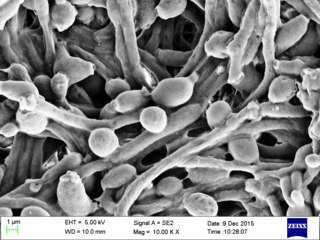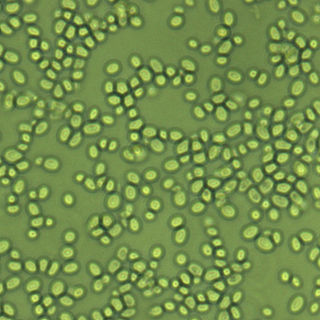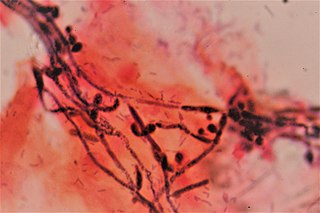
Candidiasis is a fungal infection due to any species of the genus Candida. When it affects the mouth, in some countries it is commonly called thrush. Signs and symptoms include white patches on the tongue or other areas of the mouth and throat. Other symptoms may include soreness and problems swallowing. When it affects the vagina, it may be referred to as a yeast infection or thrush. Signs and symptoms include genital itching, burning, and sometimes a white "cottage cheese-like" discharge from the vagina. Yeast infections of the penis are less common and typically present with an itchy rash. Very rarely, yeast infections may become invasive, spreading to other parts of the body. This may result in fevers along with other symptoms depending on the parts involved.

Yeasts are eukaryotic, single-celled microorganisms classified as members of the fungus kingdom. The first yeast originated hundreds of millions of years ago, and at least 1,500 species are currently recognized. They are estimated to constitute 1% of all described fungal species.

Lactobacillus is a genus of gram-positive, aerotolerant anaerobes or microaerophilic, rod-shaped, non-spore-forming bacteria. Until 2020, the genus Lactobacillus comprised over 260 phylogenetically, ecologically, and metabolically diverse species; a taxonomic revision of the genus assigned lactobacilli to 25 genera.

Saccharomyces cerevisiae is a species of yeast. The species has been instrumental in winemaking, baking, and brewing since ancient times. It is believed to have been originally isolated from the skin of grapes. It is one of the most intensively studied eukaryotic model organisms in molecular and cell biology, much like Escherichia coli as the model bacterium. It is the microorganism behind the most common type of fermentation. S. cerevisiae cells are round to ovoid, 5–10 μm in diameter. It reproduces by budding.

Candida albicans is an opportunistic pathogenic yeast that is a common member of the human gut flora. It can also survive outside the human body. It is detected in the gastrointestinal tract and mouth in 40–60% of healthy adults. It is usually a commensal organism, but it can become pathogenic in immunocompromised individuals under a variety of conditions. It is one of the few species of the genus Candida that cause the human infection candidiasis, which results from an overgrowth of the fungus. Candidiasis is, for example, often observed in HIV-infected patients. C. albicans is the most common fungal species isolated from biofilms either formed on (permanent) implanted medical devices or on human tissue. C. albicans, C. tropicalis, C. parapsilosis, and C. glabrata are together responsible for 50–90% of all cases of candidiasis in humans. A mortality rate of 40% has been reported for patients with systemic candidiasis due to C. albicans. By one estimate, invasive candidiasis contracted in a hospital causes 2,800 to 11,200 deaths yearly in the US. Nevertheless, these numbers may not truly reflect the true extent of damage this organism causes, given new studies indicating that C. albicans can cross the blood–brain barrier in mice.

Lactobacillus acidophilus is a rod-shaped, Gram-positive, homofermentative, anaerobic microbe first isolated from infant feces in the year 1900. The species is most commonly found in humans, specifically the gastrointestinal tract, oral cavity, and vagina, as well as various fermented foods such as fermented milk or yogurt. The species most readily grows at low pH levels, and has an optimum growth temperature of 37 °C. Certain strains of L. acidophilus show strong probiotic effects, and are commercially used in dairy production. The genome of L. acidophilus has been sequenced.
Lactiplantibacillus plantarum is a widespread member of the genus Lactiplantibacillus and commonly found in many fermented food products as well as anaerobic plant matter. L. plantarum was first isolated from saliva. Based on its ability to temporarily persist in plants, the insect intestine and in the intestinal tract of vertebrate animals, it was designated as a nomadic organism. L. plantarum is Gram positive, bacilli shaped bacterium. L. plantarum cells are rods with rounded ends, straight, generally 0.9–1.2 μm wide and 3–8 μm long, occurring singly, in pairs or in short chains. L. plantarum has one of the largest genomes known among the lactic acid bacteria and is a very flexible and versatile species. It is estimated to grow between pH 3.4 and 8.8. Lactiplantibacillus plantarum can grow in the temperature range 12 °C to 40 °C. The viable counts of the "L. plantarum" stored at refrigerated condition (4 °C) remained high, while a considerable reduction in the counts was observed stored at room temperature.

Lacticaseibacillus casei is an organism that belongs to the largest genus in the family Lactobacillaceae, a lactic acid bacteria (LAB), that was previously classified as Lactobacillus casei. This bacteria has been identified as facultatively anaerobic or microaerophilic, acid-tolerant, non-spore-forming bacteria.

Nakaseomyces glabratus is a species of haploid yeast of the genus Nakaseomyces, previously known as Candida glabrata. Despite the fact that no sexual life cycle has been documented for this species, N. glabratus strains of both mating types are commonly found. C. glabrata is generally a commensal of human mucosal tissues, but in today's era of wider human immunodeficiency from various causes, N. glabratus is often the second or third most common cause of candidiasis as an opportunistic pathogen. Infections caused by N. glabratus can affect the urogenital tract or even cause systemic infections by entrance of the fungal cells in the bloodstream (Candidemia), especially prevalent in immunocompromised patients.
Leuconostoc mesenteroides is a species of lactic acid bacteria associated with fermentation, under conditions of salinity and low temperatures. In some cases of vegetable and food storage, it was associated with pathogenicity. L. mesenteroides is approximately 0.5-0.7 µm in diameter and has a length of 0.7-1.2 µm, producing small grayish colonies that are typically less than 1.0 mm in diameter. It is facultatively anaerobic, Gram-positive, non-motile, non-sporogenous, and spherical. It often forms lenticular coccoid cells in pairs and chains, however, it can occasionally form short rods with rounded ends in long chains, as its shape can differ depending on what media the species is grown on. L. mesenteroides grows best at 30 °C, but can survive in temperatures ranging from 10 °C to 30 °C. Its optimum pH is 5.5, but can still show growth in pH of 4.5-7.0.

Streptococcus thermophilus formerly known as Streptococcus salivarius subsp. thermophilus is a gram-positive bacterium, and a fermentative facultative anaerobe, of the viridans group. It tests negative for cytochrome, oxidase, and catalase, and positive for alpha-hemolytic activity. It is non-motile and does not form endospores. S. thermophilus is fimbriated.

Kluyveromyces marxianus in ascomycetous yeast and member of the genus, Kluyveromyces. It is the sexual stage of Atelosaccharomyces pseudotropicalis also known as Candida kefyr. This species has a homothallic mating system and is often isolated from dairy products.

Kluyveromyces lactis is a Kluyveromyces yeast commonly used for genetic studies and industrial applications. Its name comes from the ability to assimilate lactose and convert it into lactic acid.
A killer yeast is a yeast, such as Saccharomyces cerevisiae, which is able to secrete one of a number of toxic proteins which are lethal to susceptible cells. These "killer toxins" are polypeptides that kill sensitive cells of the same or related species, often functioning by creating pores in target cell membranes. These yeast cells are immune to the toxic effects of the protein due to an intrinsic immunity. Killer yeast strains can be a problem in commercial processing because they can kill desirable strains. The killer yeast system was first described in 1963. Study of killer toxins helped to better understand the secretion pathway of yeast, which is similar to those of more complex eukaryotes. It also can be used in treatment of some diseases, mainly those caused by fungi.

Vaginal yeast infection, also known as candidal vulvovaginitis and vaginal thrush, is excessive growth of yeast in the vagina that results in irritation. The most common symptom is vaginal itching, which may be severe. Other symptoms include burning with urination, a thick, white vaginal discharge that typically does not smell bad, pain during sex, and redness around the vagina. Symptoms often worsen just before a woman's period.

Hafnia is a genus of Gram-negative, facultatively anaerobic, rod-shaped bacteria in the family Hafniaceae.
Candida blankii is a species of budding yeast (Saccharomycotina) in the family Saccharomycetaceae. The yeast may be a dangerous pathogen and resistant to treatment in human hosts. Research on the fungi has therapeutic, medical and industrial implications.
Microbial food cultures are live bacteria, yeasts or moulds used in food production. Microbial food cultures carry out the fermentation process in foodstuffs. Used by humans since the Neolithic period fermentation helps to preserve perishable foods and to improve their nutritional and organoleptic qualities. As of 1995, fermented food represented between one quarter and one third of food consumed in Central Europe. More than 260 different species of microbial food culture are identified and described for their beneficial use in fermented food products globally, showing the importance of their use.
Limosilactobacillus pontis is a rod-shaped, Gram-positive facultatively anaerobic bacterium. Along with other Lactobacillus species, it is capable of converting sugars, such as lactose, into lactic acid. Limosilactobacillus pontis is classified under the phylum Bacillota, class Bacilli, and is a member of the family Lactobacillaceae and is found to be responsible for the fermentation of sourdough, along with many other Lactobacillus species. This microorganism produces lactic acid during the process of fermentation, which gives sourdough bread its characteristic sour taste.













